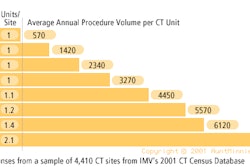CHICAGO - Electrocardiographic (ECG) gating of coronary CT images has become something of a wunderkind, owing to its ability to reduce motion artifacts. But except for a few small vessels nearest the heart, the technique does not improve the odds of diagnosing pulmonary embolism.
Such is the conclusion of Dr. Antonio Schuster and colleagues from the department of radiology at the University Hospital of Innsbruck, Austria. In the pulmonary embolism sessions of the RSNA meeting Sunday, Schuster presented a study of 37 patients with clinically suspected PE. The study compared retrospective ECG-gated to non-ECG-gated contrast-enhanced multidetector-row CT in the analysis of pulmonary embolism.
"[Dr.] Schoepf showed in Radiology in 1999 that ECG gating improves the image quality of thin-section CT scans of the lung by reducing motion artifacts," Schuster said (September 1999, Vol. 212:3, pp: 649-654).
"Two imaging datasets were calculated, one with and one without ECG gating," he said. In single data acquisitions of 35-42 seconds, the researchers performed contrast-enhanced spiral CT using a Somatom Plus4 Volume Zoom (Siemens, Erlangen, Germany), using 4x2.5 mm collimation, pitch of 1.5-2 depending on heart rate, and table feed ranging from 3.8 to 5 mm depending on pitch, Schuster said. Non-ionic contrast (120 ml) was administered using a flow rate of 4 ml/s. The reconstruction interval was 3 mm.
Two experienced readers, working independently, analyzed the datasets.
"In 20 of 37 patients, pulmonary embolism was diagnosed by both methods," Schuster said. "We found no significant difference between the ECG-gated and non-ECG-gated datasets.... In 740 segmental arteries, with non-ECG gated imaging we found 101 pulmonary emboli, while in the ECG-gated datasets we found 103 pulmonary emboli. In the 180 subsegmental arteries studied, we found in the non-ECG-gated dataset 93 pulmonary emboli, whereas in the ECG dataset we found 94."
ECG provides high temporal resolution by suppressing motion artifacts, thus reducing blurring and double contours in the images. However, the longer scan times and breath holds make the procedure more difficult for the patient. And except in some arteries immediately adjacent to the heart, the subjectively improved delineation of arteries does not provide any additional diagnostic information.
"In our opinion, retrospective ECG-gated multidetector CT may offer minor advantages in detecting pulmonary embolism in paracardiac arteries, but this [advantage] seems to be overruled by the disadvantages of this technique of imaging pulmonary embolism," he said.
A comment from session moderator Dr. Lawrence Goodman, professor of radiology at the Medical College of Wisconsin in Milwaukee, ended the presentation.
"It would seem that you're only getting an advantage with ECG with segmental or subsegmental emboli just adjacent to the heart," Goodman said. "Further away it doesn't make much difference." And because the number of patients with isolated subsegmental emboli in that region is very small, "in order to prove any kind of advantage (to ECG gating) you'd have to have thousands of patients," he said.
By Eric BarnesAuntMinnie.com staff writer
November 25, 2001
For the rest of our coverage of the 2001 RSNA meeting, go to our RADCast@RSNA 2001.
Copyright © 2001 AuntMinnie.com



















